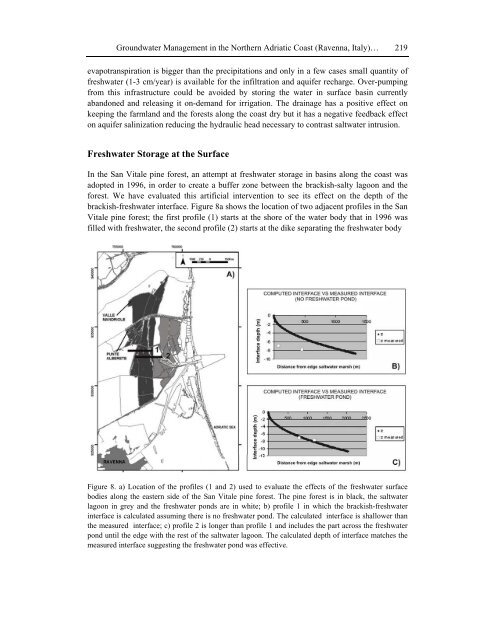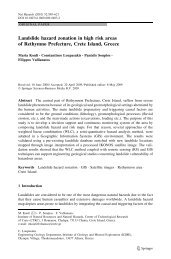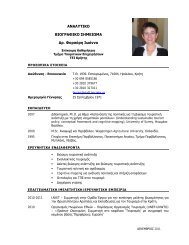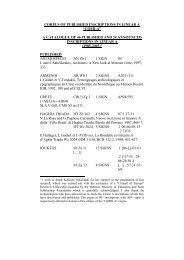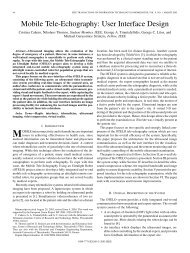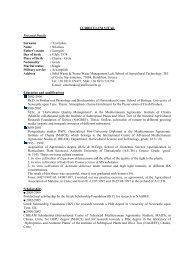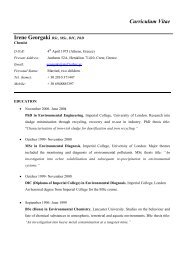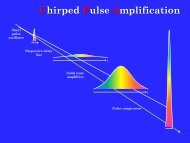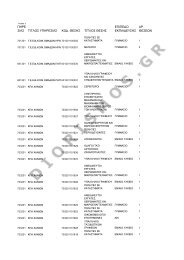- Page 3:
GROUNDWATER: MODELLING, MANAGEMENT
- Page 6 and 7:
Copyright © 2009 by Nova Science P
- Page 8 and 9:
vi Chapter 8 Chapter 9 Chapter 10 C
- Page 10 and 11:
viii Luka F. König and Jonas L. We
- Page 12 and 13:
x Luka F. König and Jonas L. Weiss
- Page 14 and 15:
xii Luka F. König and Jonas L. Wei
- Page 16 and 17:
xiv Luka F. König and Jonas L. Wei
- Page 19:
SHORT COMMUNICATION
- Page 22 and 23:
4 Goloka Behari Sahoo and Chittaran
- Page 24 and 25:
6 Goloka Behari Sahoo and Chittaran
- Page 26 and 27:
8 Goloka Behari Sahoo and Chittaran
- Page 28 and 29:
Table 2. Number of Samples in Train
- Page 30 and 31:
12 Goloka Behari Sahoo and Chittara
- Page 32 and 33:
14 Goloka Behari Sahoo and Chittara
- Page 35 and 36:
In: Groundwater: Modelling, Managem
- Page 37 and 38:
GIS-Based Aquifer Modeling and Plan
- Page 39 and 40:
GIS-Based Aquifer Modeling and Plan
- Page 41 and 42:
GIS-Based Aquifer Modeling and Plan
- Page 43 and 44:
GIS-Based Aquifer Modeling and Plan
- Page 45 and 46:
GIS-Based Aquifer Modeling and Plan
- Page 47 and 48:
GIS-Based Aquifer Modeling and Plan
- Page 49 and 50:
GIS-Based Aquifer Modeling and Plan
- Page 51 and 52:
GIS-Based Aquifer Modeling and Plan
- Page 53 and 54:
GIS-Based Aquifer Modeling and Plan
- Page 55 and 56:
GIS-Based Aquifer Modeling and Plan
- Page 57 and 58:
GIS-Based Aquifer Modeling and Plan
- Page 59 and 60:
GIS-Based Aquifer Modeling and Plan
- Page 61 and 62:
GIS-Based Aquifer Modeling and Plan
- Page 63 and 64:
GIS-Based Aquifer Modeling and Plan
- Page 65 and 66:
GIS-Based Aquifer Modeling and Plan
- Page 67 and 68:
GIS-Based Aquifer Modeling and Plan
- Page 69 and 70:
GIS-Based Aquifer Modeling and Plan
- Page 71 and 72:
GIS-Based Aquifer Modeling and Plan
- Page 73 and 74:
GIS-Based Aquifer Modeling and Plan
- Page 75 and 76:
GIS-Based Aquifer Modeling and Plan
- Page 77 and 78:
GIS-Based Aquifer Modeling and Plan
- Page 79 and 80:
GIS-Based Aquifer Modeling and Plan
- Page 81 and 82:
GIS-Based Aquifer Modeling and Plan
- Page 83 and 84:
GIS-Based Aquifer Modeling and Plan
- Page 85 and 86:
GIS-Based Aquifer Modeling and Plan
- Page 87 and 88:
GIS-Based Aquifer Modeling and Plan
- Page 89 and 90:
GIS-Based Aquifer Modeling and Plan
- Page 91 and 92:
GIS-Based Aquifer Modeling and Plan
- Page 93 and 94:
GIS-Based Aquifer Modeling and Plan
- Page 95:
GIS-Based Aquifer Modeling and Plan
- Page 98 and 99:
80 Sabrina Saponaro, Sara Puricelli
- Page 100 and 101:
82 Sabrina Saponaro, Sara Puricelli
- Page 102 and 103:
84 Sabrina Saponaro, Sara Puricelli
- Page 104 and 105:
86 Sabrina Saponaro, Sara Puricelli
- Page 106 and 107:
88 Sabrina Saponaro, Sara Puricelli
- Page 108 and 109:
90 Sabrina Saponaro, Sara Puricelli
- Page 110 and 111:
92 Sabrina Saponaro, Sara Puricelli
- Page 112 and 113:
94 Sabrina Saponaro, Sara Puricelli
- Page 114 and 115:
96 Sabrina Saponaro, Sara Puricelli
- Page 116 and 117:
98 Sabrina Saponaro, Sara Puricelli
- Page 118 and 119:
100 Sabrina Saponaro, Sara Puricell
- Page 120 and 121:
102 Sabrina Saponaro, Sara Puricell
- Page 122 and 123:
104 Sabrina Saponaro, Sara Puricell
- Page 124 and 125:
106 Sabrina Saponaro, Sara Puricell
- Page 126 and 127:
108 Sabrina Saponaro, Sara Puricell
- Page 128 and 129:
110 Sabrina Saponaro, Sara Puricell
- Page 131 and 132:
In: Groundwater: Modelling, Managem
- Page 133 and 134:
Groundwater Interactions with Surfa
- Page 135 and 136:
Groundwater Interactions with Surfa
- Page 137 and 138:
Groundwater Interactions with Surfa
- Page 139 and 140:
Groundwater Interactions with Surfa
- Page 141 and 142:
Groundwater Interactions with Surfa
- Page 143 and 144:
Groundwater Interactions with Surfa
- Page 145 and 146:
Groundwater Interactions with Surfa
- Page 147 and 148:
Groundwater Interactions with Surfa
- Page 149:
Groundwater Interactions with Surfa
- Page 152 and 153:
134 Marek Šváb and Lenka Wimmerov
- Page 154 and 155:
136 Marek Šváb and Lenka Wimmerov
- Page 156 and 157:
138 Marek Šváb and Lenka Wimmerov
- Page 158 and 159:
140 Marek Šváb and Lenka Wimmerov
- Page 160 and 161:
142 Marek Šváb and Lenka Wimmerov
- Page 162 and 163:
144 Marek Šváb and Lenka Wimmerov
- Page 164 and 165:
146 Marek Šváb and Lenka Wimmerov
- Page 167 and 168:
In: Groundwater: Modelling, Managem
- Page 169 and 170:
Fundamentals of Groundwater Modelli
- Page 171 and 172:
Fundamentals of Groundwater Modelli
- Page 173 and 174:
Fundamentals of Groundwater Modelli
- Page 175 and 176:
Fundamentals of Groundwater Modelli
- Page 177 and 178:
Fundamentals of Groundwater Modelli
- Page 179 and 180:
Fundamentals of Groundwater Modelli
- Page 181 and 182:
6.0. Model Calibration Fundamentals
- Page 183 and 184:
Fundamentals of Groundwater Modelli
- Page 185 and 186: In: Groundwater: Modelling, Managem
- Page 187 and 188: 2. Subsurface Contaminants Contamin
- Page 189 and 190: Contaminants in Groundwater and the
- Page 191 and 192: Contaminants in Groundwater and the
- Page 193 and 194: Contaminants in Groundwater and the
- Page 195 and 196: Contaminants in Groundwater and the
- Page 197 and 198: Contaminants in Groundwater and the
- Page 199 and 200: 6.2. In Groundwater Contaminants in
- Page 201 and 202: Contaminants in Groundwater and the
- Page 203 and 204: Contaminants in Groundwater and the
- Page 205 and 206: In: Groundwater: Modelling, Managem
- Page 207 and 208: Preliminary Studies for Designing a
- Page 209 and 210: Simulation Study Preliminary Studie
- Page 211 and 212: Preliminary Studies for Designing a
- Page 213 and 214: Preliminary Studies for Designing a
- Page 215 and 216: Preliminary Studies for Designing a
- Page 217 and 218: Water Budget Preliminary Studies fo
- Page 219 and 220: Preliminary Studies for Designing a
- Page 221 and 222: In: Groundwater: Modelling, Managem
- Page 223 and 224: Figure 1. Location of the study are
- Page 225 and 226: Table 1. Continued EVENT BEGINNING
- Page 227 and 228: Groundwater Management in the North
- Page 229 and 230: Groundwater Management in the North
- Page 231 and 232: Groundwater Management in the North
- Page 233 and 234: Groundwater Management in the North
- Page 235: Groundwater Management in the North
- Page 239 and 240: Groundwater Management in the North
- Page 241 and 242: Groundwater Management in the North
- Page 243 and 244: Groundwater Management in the North
- Page 245 and 246: Groundwater Management in the North
- Page 247: Groundwater Management in the North
- Page 250 and 251: 232 Franco Cucchi, Giuliana Frances
- Page 252 and 253: 234 Franco Cucchi, Giuliana Frances
- Page 254 and 255: 236 Franco Cucchi, Giuliana Frances
- Page 256 and 257: 238 Franco Cucchi, Giuliana Frances
- Page 258 and 259: Table 1. Chemical and isotopical co
- Page 260 and 261: Table 1. Continued Borehole ID Type
- Page 262 and 263: Table 2. Univariate overview of the
- Page 264 and 265: 246 Franco Cucchi, Giuliana Frances
- Page 266 and 267: 248 Franco Cucchi, Giuliana Frances
- Page 268 and 269: 250 Franco Cucchi, Giuliana Frances
- Page 270 and 271: 252 Franco Cucchi, Giuliana Frances
- Page 272 and 273: 254 Franco Cucchi, Giuliana Frances
- Page 274 and 275: 256 Franco Cucchi, Giuliana Frances
- Page 277 and 278: In: Groundwater: Modelling, Managem
- Page 279 and 280: Analytical and Numerical Solutions.
- Page 281 and 282: Analytical and Numerical Solutions.
- Page 283 and 284: Analytical and Numerical Solutions.
- Page 285 and 286: Analytical and Numerical Solutions.
- Page 287 and 288:
Analytical and Numerical Solutions.
- Page 289 and 290:
Analytical and Numerical Solutions.
- Page 291 and 292:
Analytical and Numerical Solutions.
- Page 293 and 294:
Analytical and Numerical Solutions.
- Page 295 and 296:
Analytical and Numerical Solutions.
- Page 297 and 298:
Analytical and Numerical Solutions.
- Page 299 and 300:
Analytical and Numerical Solutions.
- Page 301 and 302:
Analytical and Numerical Solutions.
- Page 303 and 304:
Analytical and Numerical Solutions.
- Page 305 and 306:
Analytical and Numerical Solutions.
- Page 307:
Analytical and Numerical Solutions.
- Page 310 and 311:
292 K.L. Katsifarakis 1. Introducti
- Page 312 and 313:
294 K.L. Katsifarakis fields with v
- Page 314 and 315:
296 K.L. Katsifarakis solution to t
- Page 316 and 317:
298 K.L. Katsifarakis The aforement
- Page 318 and 319:
300 K.L. Katsifarakis If applicatio
- Page 320 and 321:
302 K.L. Katsifarakis s w (50m) 96,
- Page 322 and 323:
304 K.L. Katsifarakis well coordina
- Page 324 and 325:
306 K.L. Katsifarakis injected in a
- Page 326 and 327:
308 K.L. Katsifarakis McKinney, D.C
- Page 328 and 329:
310 Nigel J. Cassidy 1.0. Introduct
- Page 330 and 331:
312 Nigel J. Cassidy separation). U
- Page 332 and 333:
314 Nigel J. Cassidy needed to char
- Page 334 and 335:
316 Nigel J. Cassidy resolution min
- Page 336 and 337:
318 Nigel J. Cassidy al., 2005; Eve
- Page 338 and 339:
320 Nigel J. Cassidy heat. As such,
- Page 340 and 341:
322 Nigel J. Cassidy substantially
- Page 342 and 343:
324 Nigel J. Cassidy 4.2. Conductiv
- Page 344 and 345:
326 Nigel J. Cassidy Figure 6. Prin
- Page 346 and 347:
328 Nigel J. Cassidy window is then
- Page 348 and 349:
330 Nigel J. Cassidy θ - volumetri
- Page 350 and 351:
332 Nigel J. Cassidy (2000). In gen
- Page 352 and 353:
334 Nigel J. Cassidy The influence
- Page 354 and 355:
336 Nigel J. Cassidy Figure 11. Sum
- Page 356 and 357:
338 Nigel J. Cassidy 2. An upper ae
- Page 358 and 359:
340 Nigel J. Cassidy upper sand lay
- Page 360 and 361:
342 Nigel J. Cassidy Bradford J. H.
- Page 362 and 363:
344 Nigel J. Cassidy Doolittle, J.
- Page 364 and 365:
346 Nigel J. Cassidy Jardani, A., D
- Page 366 and 367:
348 Nigel J. Cassidy Revil, A., Nau
- Page 368 and 369:
350 Nigel J. Cassidy Weiller, K. W.
- Page 370 and 371:
352 Nick Cartwright, Peter Nielsen,
- Page 372 and 373:
354 Nick Cartwright, Peter Nielsen,
- Page 374 and 375:
356 Nick Cartwright, Peter Nielsen,
- Page 376 and 377:
358 Nick Cartwright, Peter Nielsen,
- Page 378 and 379:
360 Nick Cartwright, Peter Nielsen,
- Page 380 and 381:
362 A. Akber, A. Mukhopadhyay, E. A
- Page 382 and 383:
364 A. Akber, A. Mukhopadhyay, E. A
- Page 384 and 385:
366 A. Akber, A. Mukhopadhyay, E. A
- Page 386 and 387:
368 A. Akber, A. Mukhopadhyay, E. A
- Page 388 and 389:
370 A. Akber, A. Mukhopadhyay, E. A
- Page 390 and 391:
372 A. Akber, A. Mukhopadhyay, E. A
- Page 392 and 393:
374 A. Akber, A. Mukhopadhyay, E. A
- Page 394 and 395:
376 A. Akber, A. Mukhopadhyay, E. A
- Page 396 and 397:
378 A. Akber, A. Mukhopadhyay, E. A
- Page 398 and 399:
380 A. Akber, A. Mukhopadhyay, E. A
- Page 400 and 401:
382 A. Akber, A. Mukhopadhyay, E. A
- Page 402 and 403:
384 A. Akber, A. Mukhopadhyay, E. A
- Page 404 and 405:
386 A. Akber, A. Mukhopadhyay, E. A
- Page 406 and 407:
388 A. Akber, A. Mukhopadhyay, E. A
- Page 408 and 409:
390 A. Akber, A. Mukhopadhyay, E. A
- Page 410 and 411:
392 Index Bangladesh, 188 banks, 11
- Page 412 and 413:
394 Index definition, 18, 20, 26, 1
- Page 414 and 415:
396 Index goals, 306 government, 19
- Page 416 and 417:
398 Index Miami, 349 migration, x,
- Page 418 and 419:
400 Index probability, 166, 295 pro
- Page 420 and 421:
402 Index specific heat, 90, 108 sp
- Page 422:
404 Index wetting, 86, 349 wind, 21


